The Best Mulch Options for Your Landscaping Beds
Photo: amazon.com
If you haven’t been using mulch in your garden, you’re seriously missing out on the benefits of this horticultural secret weapon. The best mulch for landscaping beds can help you conserve water, keep weeds down, and protect tender plants from unexpectedly chilly temperatures. The right mulch also can turn a drab landscaping bed into an eye-catching garden spot. However, there’s a lot more to mulch than simply dumping it into the garden. To get the best results, you need to pick a good-quality product and apply it correctly.
Below, you’ll find our recommendations for the best mulch for landscaping beds, along with tips on how to choose mulch for your garden.
- BEST OVERALL: Rio Hamza Trading Pine Bark Mulch
- BEST BANG FOR THE BUCK: Greendale Landscape Weed Barrier Fabric
- BEST ORGANIC: Southside Plants Organic Houseplant Mulch
- BEST BIODEGRADABLE: FibreDust Coco Mulch
- BEST FOR DECORATING: Rubberific Rubber Mulch
- BEST FOR POTTING: Four Winds Trading Natural Cedar Shavings
- BEST FOR GRASS & SEEDS: EZ-Straw Seeding Mulch with Tack
- BEST FOR FLOWER BEDS: ECOgardener Landscape Fabric
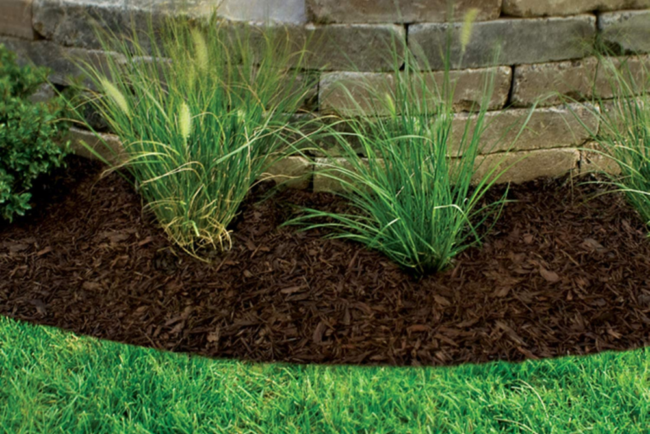
Photo: amazon.com
What to Consider When Choosing the Best Mulch
There are a few essentials to consider before choosing, buying, and bringing home bags of mulch. Here’s what you need to work out before shopping.
Type
First, decide on the type of mulch you want to use. There are many mulches, but to make things easier, we’ll divide mulch into two big buckets: organic and inorganic mulch. Organic mulches are impermanent materials that will break down over time. In addition to providing all the incredible benefits of mulch, they help condition the soil by improving its texture and adding nutrients. Inorganic mulches are materials that don’t break down. Rocks are sometimes labeled as an organic mulch, but they don’t actually break down, so that’s a bit of a misnomer. Inorganic mulches often are synthetic and can be an excellent option for keeping weeds at bay in a large garden or landscaping space.
Here’s a breakdown of some common organic mulch options:
- Straw
- Bark or wood chips
- Pine needles
- Crumbled or shredded leaves
- Grass clippings
- Sawdust
- Coco coir
Here are a few inorganic mulches you might come across:
An advantage of organic mulch is that many organic mulch materials are free. Grass clippings, for instance, are in ready supply if you have a lawn you mow regularly. Similarly, if you have leaf-shedding trees on your property, there’s another source of free mulch.
On the other hand, inorganic mulch options are longer lasting and often visually appealing. Your choice might depend on the use, such as gravel and crusher fine for paths, and organic mulches in garden beds.
Intended Application
How do you intend to use mulch in your garden? If you need to cover a large space, plastic or fabric mulch is an inexpensive, easy-to-apply option. Covering a large garden space with straw or wood chips can get pricey pretty quickly. It’s also a lot more labor-intensive to apply.
If you’re working with a large garden area, you also probably want to avoid stones or pebbles unless you’re absolutely sure of your final landscaping vision. Rocks are tough to remove once they’re down, so you want to be 100 percent sure you want them there.
Additionally, keep your aesthetic vision in mind. Consider how you want the area to look, whether you are applying mulch for practical reasons or to create a cohesive landscape that blends colors and textures. Dyed (or even natural) wood or rubber mulch is a great option for improving the look of a garden landscape. If you’re using mulch to help conserve moisture in a vegetable garden bed, straw or coco coir are natural and organic choices. They’re not the prettiest mulch options, but they definitely do the job.
Timing
The best time to mulch is before you plant anything inside your garden beds or right after, depending on the type of mulch you’re using. If you’re using landscaping fabric, you’ll need to apply that before anything else as a base layer for your bed. If you plan to use wood chips, you can place those before or after planting.
Add mulch at any time during the season, though. You might also need to touch up places here and there if you’re using organic mulch. You can use mulch to protect tender plant roots and tree saplings from unexpected freezes and thaws in fluctuating temperatures, applying the mulch at planting time (to also conserve water around the new plant’s roots) or before nighttime temperatures plummet.
Texture
Mulch texture differs depending on the type of mulch you choose. Texture has everything to do with how you want your landscaping beds to look. It can also affect how easy it is to walk on an area and how well water and air reach through the mulch layer to support healthy plants.
Nutrients
Though inorganic mulch won’t affect soil nutrients, some organic mulches will improve the nutrient content of your soil. That said, the impact is minimal, so you should still count on using fertilizer once in a while. Compost is the best mulch for improving soil nutrients, but it’s not the most attractive, cohesive option for landscaping beds. However, applying an organic mulch above compost worked into the soil can feed the soil over time.
Weed Prevention
Weeds are some of the most annoying foes a gardener has to deal with. In a large landscaping bed, a bunch of weeds can quickly overrun your healthy, beautiful plants and ruin your tidy-looking garden. Mulch can help you tackle weed problems. Some mulches are better suited to keeping down weeds, though. Landscaping fabric and plastic mulch, for instance, literally suffocate any weeds hanging around. That said, they also can suffocate the plants in the bed, and you should use caution when applying fabric in growing areas, cutting a large hole around the plant’s roots.
Organic mulches like wood chips and straw will have a similar but less intense weed-killing effect. Be careful when adding organic mulches to prevent weed growth. Don’t pile mulch too close to your plants, and adding too much can suffocate your plant roots and eventually kill them. Too much mulch isn’t necessarily a good thing, but a layer of a few inches controls weeds better than a thin layer.
Longevity
Need a durable mulch option? Most organic mulches won’t last more than a few years since they eventually decompose. The longest-lasting mulch is stone, but keep in mind some of its drawbacks. Other long-lasting options are landscape fabric (great for starting weed-free beds), plastic mulch (great for moisture and heat retention for heat-loving plants), and rubber.
Our Top Picks
Choosing the best landscaping mulch is easier if you consider type, texture, nutrients, and especially intended application. The recommendations―all from reputable companies―should suit a wide range of needs.
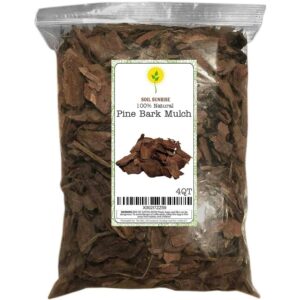
Photo: amazon.com
Natural Rio Hamza Trading Pine Bark Mulch is suitable for a variety of landscaping and gardening situations. This small bag can mulch around a single shrub or small garden bed. Indoor uses include mulching around terrarium plants for a nice contrast to plant foliage. Unlike other organic mulch options, pine bark mulch also looks great even when applied to a larger area. The 100 percent natural mulch comes in a resealable 4-quart bag, which holds about 1 gallon of pine bark.
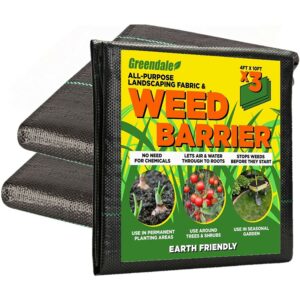
Photo: amazon.com
If weeds are your top concern, Greendale Landscape Weed Barrier Fabric is an inexpensive solution. The landscaping fabric can cut weed growth in a new garden bed. Although the fabric can suppress weeds, air and water can permeate it, so both reach the soil below. The sheets in the package provide 120 square feet of coverage to help suffocate stubborn weeds. Add a more attractive mulch on top of the fabric.
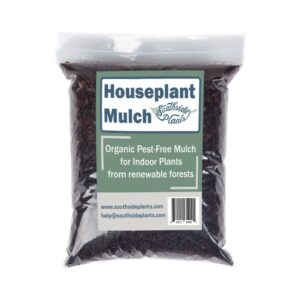
Photo: amazon.com
Southside Plants Store Organic Houseplant Mulch is visually appealing and sustainably sourced from New Zealand pine forests. It’s an excellent choice for potted plants, indoors and out. In addition to looking attractive, the mulch helps prevent water from evaporating from pots as rapidly and can provide some weed suppression. The dark, natural mulch shields a plant’s roots from intense heat during warmer months. As the pine bark breaks down, it helps enrich the soil. The amount in this 2-quart bag should cover a few potted houseplants.
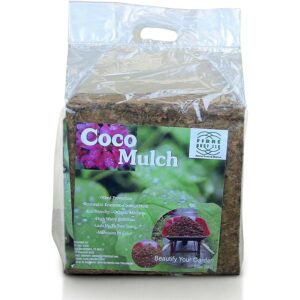
Photo: amazon.com
FibreDust Coco Mulch is 100 percent sourced from coconut husks, with no additives. The organic mulch presents an attractive rust-colored hue when placed in garden beds. It arrives compressed; just add 4 gallons of water and watch it expand. A single block yields approximately 2 cubic feet of mulch. Although the coco mulch breaks down, it can maintain its look and plant protection features for about two years.
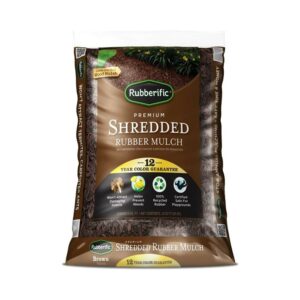
Photo: amazon.com
The recycled Rubberific Rubber Mulch is an excellent choice for decorating perennial landscaping beds. The dark-colored rubber blends into the landscape and won’t fade when exposed to sun and water. Use of the mulch, especially in play areas, can save gardeners time and future expense, since it does not break down. It’s best as a top dressing over high-quality soil or in nonplanting areas of the landscape. One 0.8-cubic-foot bag can cover 9 square feet.
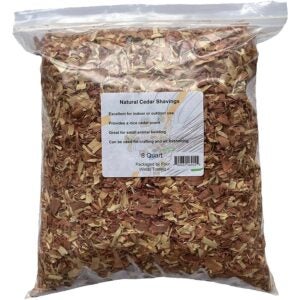
Photo: amazon.com
The lovely scent of Four Winds Trading Natural Cedar Shavings will appeal to gardeners but not to pests. The cedar chips can help freshen the air in your home or near a patio and keep your soil weed-free and moist. The 8-quart bag is great for a collection of small pots, but these cedar shavings are also available in a larger 16-quart package.
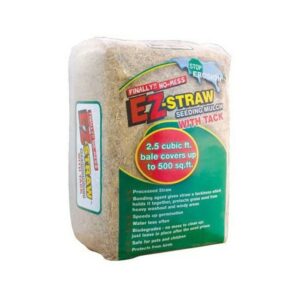
Photo: amazon.com
Straw mulch like this EZ Straw Seeding Mulch is easy to apply, and while it’s not the most beautiful mulch option out there, straw mulch can work wonders. Adding straw to a landscaping area helps protect grass seeds from the elements and hungry critters so they can take root. It’s also biodegradable and safe for use around kids and pets. A thick layer of straw mulch is a good alternative for edible gardens to protect newly planted seeds or tender seedlings and help retain water. This 2.5-cubic-foot bale covers up to 500 square feet, depending on depth.
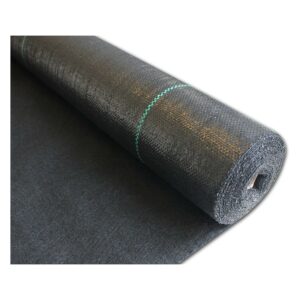
Photo: amazon.com
Add the heavy-duty ECOgardener Landscape Fabric to your new flower beds to prevent weed growth. Just cut and install. The material also helps conserve moisture and comes with a 30-day guarantee. Note that landscape fabric is best for use in a perennial flower bed. Use a different type of mulch for plots that contain mostly annuals. Since you’ll need to cut holes to accommodate the flowers, this mulch isn’t ideal if you are replanting year after year.
The Advantages of Using Mulch
Why use mulch? There are many advantages to using this material in your garden and landscaping beds. Here’s why you should consider adding mulch to your gardening tool kit:
- Conserve water. Water loss is inevitable in a garden, especially at the peak of the hot weather with the sun beating down on your beds. Adding mulch can help conserve moisture and prevent water loss that occurs due to evaporation. You won’t have to deal with rapidly drying soil as much if you use mulch, and you can save some water.
- Regulate temperature. It can be hard to manage soil temperatures throughout the season, especially as the weather fluctuates. Adding mulch around the root zones of your plants can help regulate soil temperature. In the hot weather, mulch cools the soil, and in the cooler months, mulch keeps plant roots warm.
- Add nutrients and improve soil. Adding organic mulches can help improve the nutrient content of soil over time. Organic mulch breaks down slowly and improves the condition and texture of soil.
- Prevent disease. A lot of beneficial organisms live in the soil, but so do a bunch of nasty ones. Many fungal diseases find their way onto and into plants because of splashing water. Mulch acts as a barrier between plant foliage and contaminated soil.
- Beautify your garden. Mulch also helps tie landscaping spaces together. Wood chips, rubber mulch, and rocks or gravel are most often used for aesthetic purposes. They are available in several colors, from natural to red.
FAQs About Your New Mulch
Do you still have questions about landscaping mulch? Here are some answers to frequently asked mulch questions.
Q. Is all mulch organic?
No, not all mulch is organic. Some mulches are made of inorganic materials. These synthetic mulches have their place in gardening and agriculture, though, and have many benefits. They’re easy to apply, effective, and sometimes cost less per square foot than some organic mulches, like wood chips.
Q. What are the types of mulch?
There are two main types of mulch, organic and inorganic. Here’s a full list of all the kinds of mulch you can use in your garden:
- Compost
- Straw
- Hay
- Coco coir
- Shredded newspaper
- Cardboard
- Shredded leaves
- Pine needles
- Stones, pebbles, rocks
- Sawdust
- Crushed seashells
- Grass clippings
- Wood chips
- Tree bark
- Landscaping fabric
- Black or red plastic mulch
- Rubber mulch (sometimes called rubberwood chips)
Q. What type of mulch lasts the longest?
Inorganic mulches are the longest lasting, which makes them good for permanent garden plants, beds, or paths. Rubber and landscaping fabric won’t break down like other types of mulch. Landscaping fabric eventually needs replacing, though, but not for years.
The longest lasting of them all? Stones, rocks, and pebbles by far. Just know that rocks have disadvantages. They’re heavy, cumbersome, and difficult to remove if you decide to change your garden around.
Q. Does mulching grass make it grow faster?
Mulching grass can help improve the nutrient availability for your lawn and help it grow healthier. Hold on, though. Grass mulching doesn’t involve just any type of mulch. It specifically requires finely chopped-up grass clippings or an organic compost. In addition to adding nutrients, mulching your lawn can help with moisture retention, which, in turn, can help you reduce your water use and save money on your water bill.
Q. Do I need to pull weeds before mulching?
You don’t need to, but it’s a good idea. You’ll get better results if you weed before applying mulch. Weeds are considered garden intruders for a reason. They’re hard to get rid of. While you might get lucky, pulling them up helps keep them from popping up again in the future. When pulling weeds, you have to get them by the taproot. Simply cutting them at the soil line won’t permanently kill them.
Q. How often should you remove old mulch?
According to lawn-care company Reddi Lawn Care, you should reapply mulch every five or six years. You might need to replace mulch sooner or add some depth for various reasons, such as if an area has heavy foot traffic.


Comments are closed.